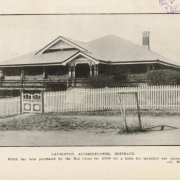Lauriston House

Photo of Lauriston from Page 28 of the Queenslander Pictorial, supplement to The Queenslander, 25 October, 1919. Image courtesy of SLQ
Following a recent inquiry about a house in Chasely St, Auchenflower we found the interesting story of Lauriston House at number 27 Chaseley Street which had several strong connections to World War 1.
The house was originally owned by William Jack who was a draper with his business William Jack & Co being located in Queen Street. He and his wife Mary and children lived in the grand house with beautiful gardens and a tennis court until October 1919 when it was sold. During their time in the house there were highs and lows for the family most notably including the wedding of their eldest daughter Mary Jack who was married at the house while sadly their son Corporal William Neilson Leslie Jack died of wounds in France in October 1917 at the age of 22. He received several medals for his service and his name is commemorated in the Toowong Memorial Park.
The house was sold in October 1919 to the Red Cross for the sum of £3000 who intended to use the house as a convalescent home for returned war nurses. The Red Cross had begun campaigning and fundraising for such a rest home in late 1918. It made this impassioned plea in The Telegraph, Thursday 31 October 1918:
How they braved the awful mud of Flan-ders and the terrifying shell fire at Trois, Arbres, and Grevillers. The dis-comforts and overwork of Poperinghe, the bitter cold and snow of Wimereux. All these trials were laughed at by those devoted women, who, in spite of them all, worked bravely and success-fully to save life and limb. How devoted they were, how devoted they still are. Already many, alas, have re-turned broken in health. What can we do for them? Homes and hospitals we have for our soldiers. Where is the home for our Queensland war nurses? I am ashamed to say we have none. Then give, give freely if you can, but give, and we will provide for our war worn heroines as a great and generous country, such as Queensland is, should provide.
Lauriston House was officially opened as a rest home for nurses on 18 November 1919 and could comfortably accommodate 13 nurses. It was described as having:
“six well furnished bedrooms, each containing two beds, a wide sleeping-out veranda, and a drawing-room, opening into a commodious dining-room, arranged with small tables. Gas is installed, and a large gas stove is a feature of the well equipped kitchen, and the septic tank system exists throughout the house. Other features include a well equipped laundry, store rooms, and linen cup-boards”. (Home for Nurses, The Week, Fri 21 Nov 1919, p5)
Accommodation at the home was open to nurses of the AIF, who despite being discharged as fit, needed some extra rest and attention. The nurses could stay for two weeks and must present a certificate from their ‘medical adviser’ in order to be issued with the ‘necessary card for admission. (Women’s Realm, Saturday 17 April 1920, page 15)
The home continued to operate until November 1920 when it “was reluctantly cleared, the very small number of nurses who required convalescent treatment not justifying the expense of its upkeep” (Daily Mail Saturday 6 August 1921, page 8).
Following its decommissioning the Red Cross tried unsuccessfully to sell the house and it seems it was rented out instead finally being used in the 1930s by several musicians, Miss Merlena Uewells and Mr. Hardy Gerhardy, who advertised piano, cello and singing lessons and also hosted musical evenings.
The house remains high on the hill opposite the entrance to the Wesley Hospital although it has been modified extensively and it’s spacious grounds subdivided for other housing. The only tell tale connection to the original house is the chimney.
Research: Philippa Stanford, Nick Feros, Sharon Racine
Compiled by Philippa Stanford


